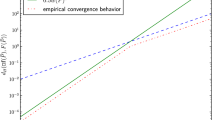Abstract
The relaxation method for linear inequalities is studied and new bounds on convergence obtained. An asymptotically tight estimate is given for the case when the inequalities are processed in a cyclical order. An improvement of the estimate by an order of magnitude takes place if strong underrelaxation is used. Bounds on convergence usually involve the so-called condition number of a system of linear inequalities, which we estimate in terms of their coefficient matrix.
Similar content being viewed by others
References
S. Agmon, “The relaxation method for linear inequalities”,Canadian Journal of Mathematics 6 (1954) 382–392.
Y. Censor, P.P.B. Eggermont and D. Gordon “Strong underrelaxation in Kaczmarz's method for inconsistent systems”, Technical Report MIPG62, Department of Radiology, University of Pennsylvania, Philadelphia, PA, December, 1981.
R.W. Cottle and J.-S. Pang, “On solving linear complementarity problems as linear programs”,Mathematical Programming Study 7 (1978) 88–107.
J.L. Goffin, “On the nonpolynomiality of the relaxation method for systems of linear inequalities”,Mathematical Programming 22 (1982) 93–103.
J.L. Goffin, “Acceleration in the relaxation method for linear inequalities and subgradient optimization”, in: E.A. Nurminski, ed., Progress in Nondifferentiable Optimization (IIASA, Laxenburg, 1982) pp. 29–59.
J.L. Goffin, “The relaxation method for solving system of linear inequalities”,Mathematics of Operations Research 5 (1980) 388–414.
G.T. herman,Image reconstructions from projections, the fundamentals of computerized tomography (Academic Press, New York, 1980).
G.T. Herman, “A relaxation method for reconstructing objects from noisy X-rays”,Mathematical Programming 8 (1975) 1–19.
A.S. Householder and F.L. Bauer, “On certain iterative methods for solving linear systems”,Numerische Mathematik 2 (1960) 55–59.
L.G. Khachian, “A polynomial algorithm in linear programming”,Doklady Akademii Nauk SSSR 244 (1979) 1093–1095 [translated inSoviet Mathematics Doklady 20 (1979) 191–194].
Th. Motzkin and I.J. Schoenberg, “The relaxation method for linear inequalities”,Canadian Journal of Mathematics 6 (1954) 393–404.
W. Oettli, “An iterative method, having a linear rate of convergence, for solving a pair of dual linear programs”,Mathematical Programming 3 (1972) 302–311.
M.J. Todd, “Some results on the relaxation methods for linear inequalities”, Technical Report 419, SORIE Cornell University, Ithaca, NY, April, 1979.
Author information
Authors and Affiliations
Rights and permissions
About this article
Cite this article
Mandel, J. Convergence of the cyclical relaxation method for linear inequalities. Mathematical Programming 30, 218–228 (1984). https://doi.org/10.1007/BF02591886
Received:
Revised:
Issue Date:
DOI: https://doi.org/10.1007/BF02591886




